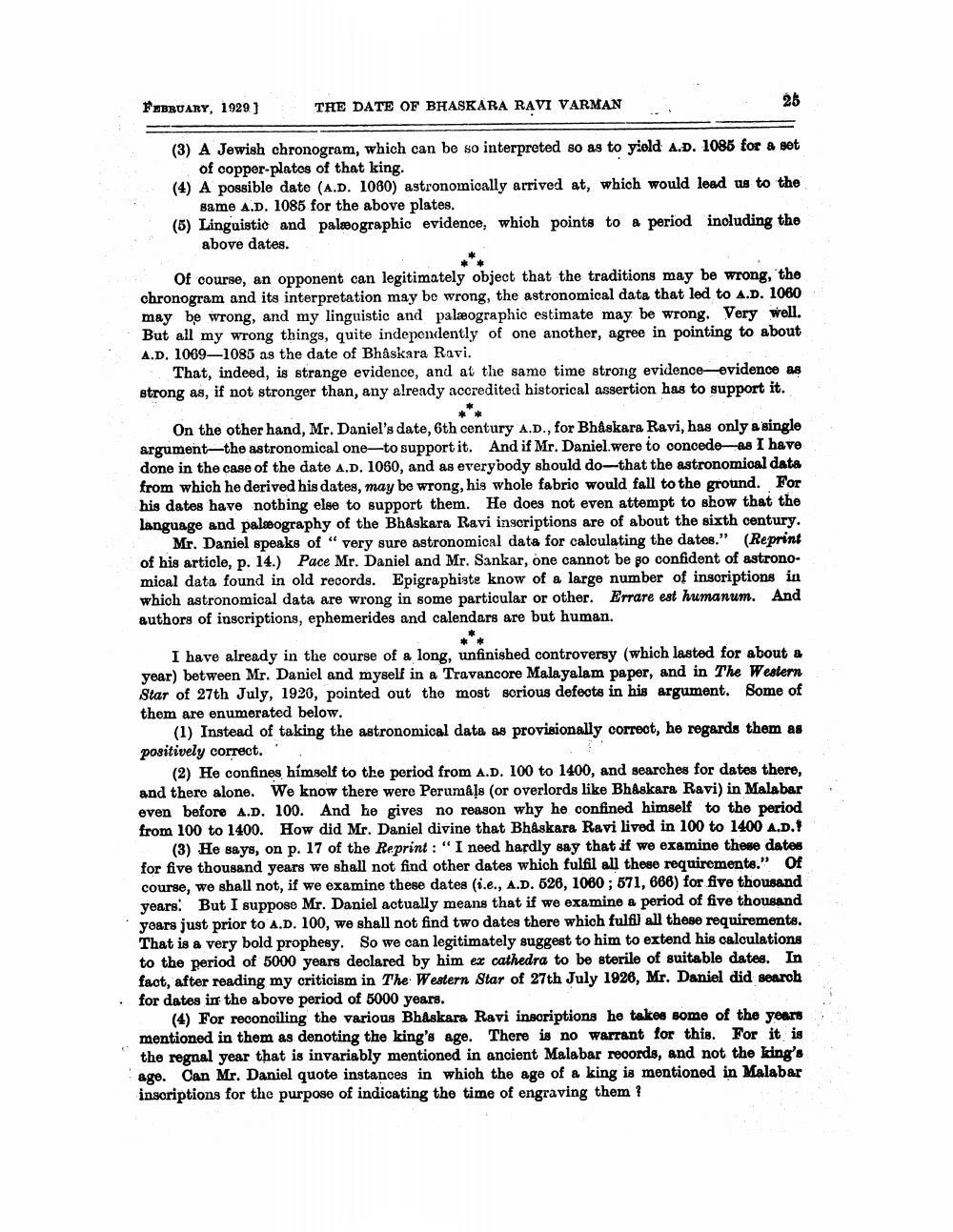________________
FEBRUARY, 1929)
THE DATE OF BHASKARA RAVI VARMAN
26
(3) A Jewish chronogram, which can be so interpreted so as to yield A.D. 1085 for a set
of copper-plates of that king. (4) A possible date (A.D. 1080) astronomically arrived at, which would lead us to the
same A.D. 1085 for the above plates. (5) Linguistic and palæographic evidence, which points to a period including the
above dates.
Of course, an opponent can legitimately object that the traditions may be wrong, the chronogram and its interpretation may be wrong, the astronomical data that led to A.D. 1060 may be wrong, and my linguistic and palæographic estimate may be wrong. Very well. But all my wrong things, quite independently of one another, agree in pointing to about A.D. 1069–1085 as the date of Bhaskara Ravi.
That, indeed, is strange evidence, and at the same time strong evidence-evidence as strong as, if not stronger than, any already accredited historical assertion has to support it.
On the other hand, Mr. Daniel's date, 6th century A.D., for Bhaskara Ravi, has only a single argument-the astronomical one-to support it. And if Mr. Daniel.were to concede as I have done in the case of the date A.D. 1060, and as everybody should do that the astronomical data from which he derived his dates, may be wrong, his whole fabrio would fall to the ground. For his dates have nothing else to support them. He does not even attempt to show that the language and palæography of the Bhaskara Ravi inscriptions are of about the sixth century.
Mr. Daniel speaks of " very sure astronomical data for calculating the dates." (Reprint of his article, p. 14.) Pace Mr. Daniel and Mr. Sankar, one cannot be so confident of astronomical data found in old records. Epigraphiste know of a large number of inscriptions in which astronomical data are wrong in some particular or other. Errare est humanum. And authors of inscriptions, ephemerides and calendars are but human.
I have already in the course of a long, unfinished controversy (which lasted for about a year) between Mr. Daniel and myself in a Travancore Malayalam paper, and in The Western Star of 27th July, 1926, pointed out the most serious defects in his argument. Some of them are enumerated below.
(1) Instead of taking the astronomical data as provisionally correct, he regards them as positively correct.
(2) He confines himself to the period from A.D. 100 to 1400, and searches for dates there, and there alone. We know there were Perumals (or Overlords like Bhaskara Ravi) in Malabar even before A.D. 100. And he gives no reason why he confined himself to the period from 100 to 1400. How did Mr. Daniel divine that Bhaskara Ravi lived in 100 to 1400 A.D.!
(3) He says, on p. 17 of the Reprint : "I need hardly say that if we examine these dates for five thousand years we shall not find other dates which fulfil all these requirements." Of course, we shall not, if we examine these dates (i.e., A.D. 526, 1060; 571, 666) for five thousand years. But I suppose Mr. Daniel actually means that if we examine a period of five thousand years just prior to A.D. 100, we shall not find two dates there which fulfil all these requirements. That is a very bold prophesy. So we can legitimately suggest to him to extend his calculations to the period of 5000 years declared by him ex cathedra to be sterile of suitable dates. In fact, after reading my criticism in The Western Star of 27th July 1926, Mr. Daniel did search for dates in the above period of 5000 years.
(4) For reconciling the various Bhaskara Ravi inscriptions he takes some of the years mentioned in them as denoting the king's age. There is no warrant for this. For it is the regnal year that is invariably mentioned in ancient Malabar records, and not the king's age. Can Mr. Daniel quote instances in which the age of a king is mentioned in Malabar inscriptions for the purpose of indicating the time of engraving them ?




